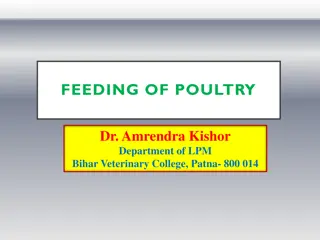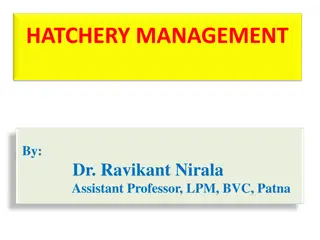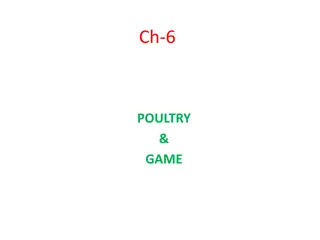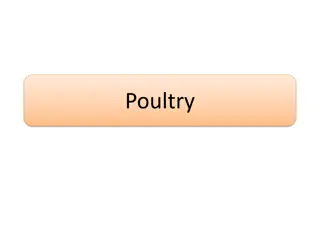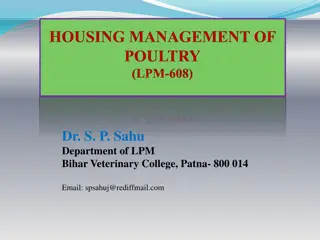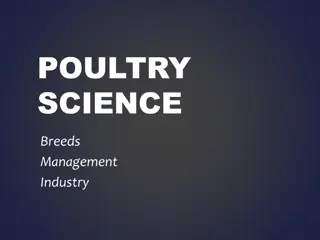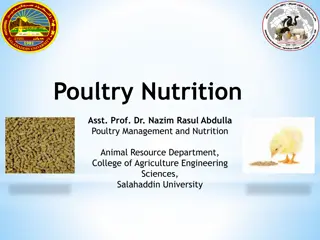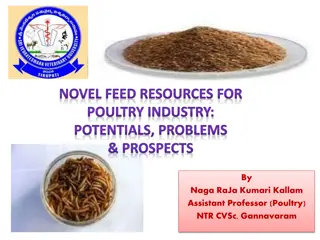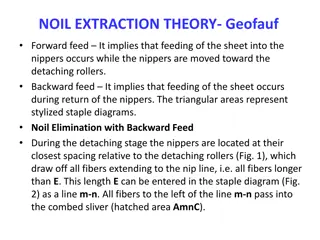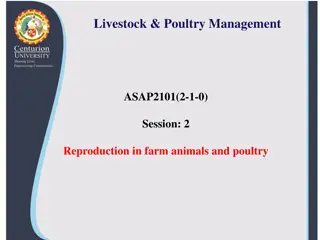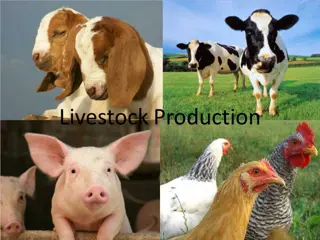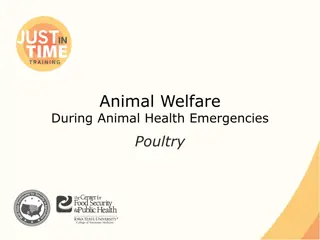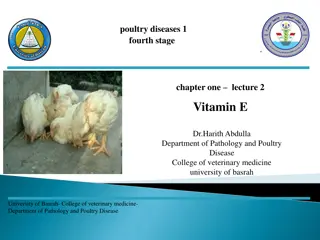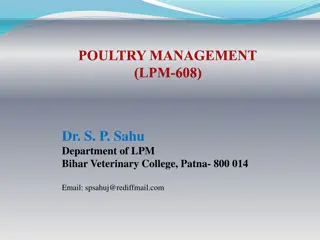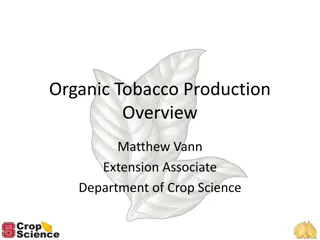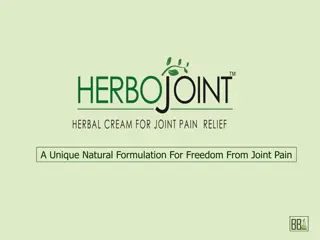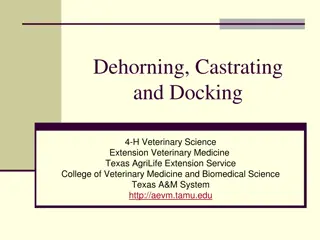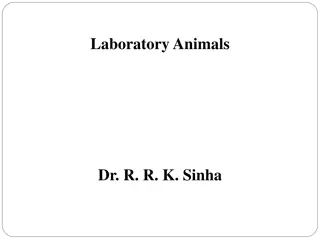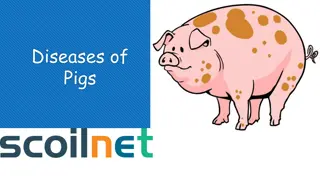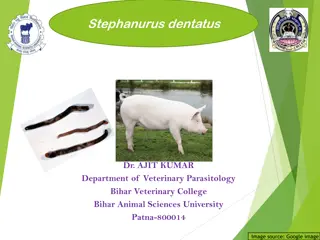Organic Feed Formulation Software: UBC Abacus for Pigs and Poultry
UBC Abacus is a software program developed at the University of British Columbia to assist farmers in formulating organic feed mixtures for poultry and pigs. It maximizes the use of home-grown ingredients, ensures nutrient needs are met, and promotes sustainability by providing on-farm control over feed formulations using cereal grains and supplementary proteins like soybean meal.
Uploaded on Sep 15, 2024 | 0 Views
Download Presentation

Please find below an Image/Link to download the presentation.
The content on the website is provided AS IS for your information and personal use only. It may not be sold, licensed, or shared on other websites without obtaining consent from the author. Download presentation by click this link. If you encounter any issues during the download, it is possible that the publisher has removed the file from their server.
E N D
Presentation Transcript
UBC Abacus A software program developed at the University of British Columbia (UBC), Vancouver, Canada to assist farmers in formulating feed mixtures for use in the production of organic poultry and pigs.
UBC Abacus The program is designed to: produce feed mixtures that meet the nutrient needs of organic poultry and pigs maximize the use of home-grown feed ingredients be simple to use on a computer
UBC Abacus: a computerized system for the on-farm formulation of organic feed mixtures for pigs and poultry Producers who want to formulate feed mixtures using home-grown or purchased cereal grains have 2 main options: Cereals only available: purchase a Supplement and mix on-farm Cereals + proteins available: purchase a Premix and mix on-farm Option 2 allows complete control over the mix and usually is the lowest-cost option. Also it maximizes the use of home-grown feeds and promotes greater sustainability.
ORGANIC FEEDSTUFFS All feed ingredients used must meet the organic standards. Local ingredients are preferred. Cereal Grains and By-products primary sources of energy in pig and poultry diets low in protein but high in carbohydrate (starch) palatable and well-digested nutrient composition is variable (test periodically if possible) organic cereals tend to be slightly lower in protein content barley, wheat, oats and corn (maize) are the main cereals used in livestock feeding
ORGANIC FEEDSTUFFS Cereal Grains Barley: medium-energy grain, with more fibre than corn Wheat: higher in energy and protein content than barley Wheat middlings: by-product of flour milling, contains the germ Oats: higher in fibre and lower in energy than other main cereals Corn: high energy value but low in protein.
ORGANIC FEEDSTUFFS Supplementary protein Sources Main protein sources used in livestock feeding are soybean and canola meals after oil extraction from the seed Soybean meal: regarded as best plant protein source for livestock feeding available in two forms: meal with 440 g protein/kg and dehulled meal with 480-500 g protein/kg energy content of soybean meal is higher than in other oilseed meals (lower in fibre) excellent amino acid profile, complementing the amino acids in cereal grains amino acids in soybean meal are highly digestible.
ORGANIC FEEDSTUFFS Supplementary Protein Sources Full-fat soybeans complete soybeans after dehulling, containing the original content of oil excellent source of both energy and protein raw beans contain anti-nutritive factors which impair protein digestion factors are inactivated by proper heat treatment (steaming, toasting or extruding).
ORGANIC FEEDSTUFFS Supplementary Protein Sources Canola (rapeseed) improved type of rapeseed that is suitable for livestock feeding. crop belongs to the mustard family and is not as palatable as soybeans. good alternative oilseed crop to soybeans in regions not suited for growing soybeans. raw seed contains factors which impair digestion factors are inactivated by proper heat treatment (steaming, toasting or extruding)
ORGANIC FEEDSTUFFS Supplementary Protein Sources Canola meal: protein and energy contents, also digestibility lower than in soybean meal Full-fat canola (canola seed) can be used to provide supplementary protein and energy maximum utilization only when the product is mechanically disrupted and heat-treated once ground, the oil is highly susceptible to oxidation
ORGANIC FEEDSTUFFS Supplementary Protein Sources Faba (field) beans annual legume that grows well in regions with mild winters and adequate summer rainfall beans store well for use on-farm beans are often regarded nutritionally as high-protein cereal grains like most legume seeds are low in methionine and cystine (amino acids) similar in energy content to barley or wheat grind before use in livestock diets
ORGANIC FEEDSTUFFS Supplementary Protein Sources Field peas like field beans a good cool-season alternative crop for regions not suited to growing soybeans can be grown in conjunction with barley similar in energy content to high-energy cereals (high in starch) higher in protein content than cereal grains grind before feeding Fish meal excellent protein source (used mainly in fish farming) acceptable if certified organic usually too expensive for on-farm use
ORGANIC FEEDSTUFFS Minerals Sodium: mainly sodium chloride, also sea salt etc. Calcium: mainly ground limestone, also ground sea-shells etc. Phosphorus: mainly dicalcium phosphate. The approved products to supply trace elements include: Iron products: ferrous carbonate, ferrous sulfate monohydrate and ferric oxide. Iodine products: calcium iodate, anhydrous calcium iodate hexahydrate and potassium iodide. Copper products: copper oxide etc. Zinc products: zinc carbonate, zinc oxide etc. Selenium products: sodium selenate and sodium selenite.
ORGANIC FEEDSTUFFS Vitamins Approved vitamins should be derived from vitamin compounds occurring naturally in feeds, or synthetic vitamins identical to natural vitamins. When the organic feed or organic animal product is to be exported to the USA, the vitamins and trace minerals have to be FDA- approved.
ORGANIC FEEDSTUFFS Yeasts and other additives Brewers Yeast (inactivated) used traditionally as a source of nutrients: other yeasts may be acceptable. Certain additives for use in ensilage, as processing aids, pellet binders etc. are permitted. Some enzyme supplements such as proteases and carbohydrases are permitted (check with certifying agency). Pure forms of amino acids are not allowed Except: L-lysine produced by biofermentation and not GM may be permitted DL-methionine (and related compounds) may be permitted in poultry feeds
NUTRIENT REQUIREMENTS ENERGY accounts for the greatest percentage of feed costs produced when the feed is digested in the gut either released as heat or absorbed into the body for metabolic purposes can be obtained from carbohydrates (mainly), fats or proteins in the feed fats yield about 2.25 times the energy provided by carbohydrates or proteins energy in excess of requirement is converted to fat and stored in the body
Energy evaluation total energy (gross energy: GE) - measured chemically GE does not indicate amount of energy useful to the animal a more precise measurement of energy is digestible energy (DE) large database of DE values for feedstuffs - used in formulating PIG diets DE values may be predicted from chemical composition a more accurate measure of useful energy is metabolizable energy (ME) takes into account energy lost both in feces and urine large database of ME values for feedstuffs - used in formulating POULTRY diets
NUTRIENT REQUIREMENTS PROTEIN The term protein usually refers to crude protein (CP; measured as nitrogen content 6.25) in tables of feedstuffs composition and requirements required in the diet as a source of amino acids (AA), building blocks for the formation of muscle tissue, eggs, etc. over 20 different AA in the body of the pig or bird 10 are essential (EAA; arginine, methionine, histidine, phenylalanine, isoleucine, threonine, leucine, tryptophan, lysine and valine), i.e. cannot be made by the body and must be derived from the diet. Cystine can supply part of the methionine requirement
NUTRIENT REQUIREMENTS SUMMARY for optimal performance the diet must provide adequate and balanced levels of EAA adequate energy, balanced in relation to AA adequate amounts of other essential nutrients all of these should be of high digestibility (bioavailability) the target nutrient values used in UBC Abacus for the feed mixtures are designed for heritage-type organic stock. NRC values or values recommended by the breeder company should be used with conventional stock.
FORMULATING A FEED MIXTURE STEPS 1. Select the appropriate worksheet for the type of feed to be mixed sow lactation, laying hen etc. Copy and download the worksheet to your computer 2. Decide on which feed ingredients are to be used 3. Adjust the nutrient levels in ingredients if analyzed data are available 4. Run UBC Abacus to calculate which combination of ingredients provides the target nutrient levels 5. Prepare a feed mixture using the amount of each ingredient obtained in step 4.
Worksheets based on MS Excel for the formulation of organic feed mixtures for pigs and poultry are shown in the following sections. Worksheet Matrix Species Feed type 1 1 Pig Dry sows and boars 1 2 Pig Lactating sows 2 3 Pig Starting pigs 2 4 Pig Growing pigs 2 5 Pig Finishing pigs 3 6 Chicken Laying stock chicks 3 7 Chicken Laying stock growing pullets 3 8 Chicken Laying stock layers/breeders 4 9 Chicken Meat birds (roasters) starting chicks 4 10 Chicken Meat birds (roasters) growing chickens 4 11 Chicken Meat birds (roasters) finishing chickens
The author: Dr Bob Blair PhD University of Aberdeen (Rowett Research Institute) Scotland (Animal Nutrition) Scientist ARC Poultry Research Centre, Roslin, Scotland Director of Poultry and Livestock Nutrition, Swift Canadian Company, Toronto Professor of Animal Science, University of Saskatchewan, Saskatoon, and Director Prairie Swine Centre DSc University of Saskatchewan (Animal Nutrition Research) Professor and Head, Animal and Poultry Science, UBC Professor Emeritus, UBC
RELATED PUBLICATIONS Nutrition and Feeding of Organic Pigs 2ndEdition (CABI, 2018) Nutrition and Feeding of Organic Poultry 2ndEdition (CABI, 2019) Nutrition and Feeding of Organic Cattle (CABI, 2012) Pig Farming, Canadian Encyclopedia (2015) A Practical Guide to the Feeding of Organic Farm Animals (5M Publishing, UK, 2017).


